Why You Should Try Outlining at Least Once
Step Three:
Outline!
Now that you know your options during the writing process, I’m going to show you how I outlined and wrote Part 1 of Sequestered Mind. You don’t necessarily have to read the story to understand my notes, as I’ll be talking about some differences between when I wrote the original version the story ten years ago (OV), where I hadn’t outlined the story and was essentially pantsing it, and the remastered version (RM), along with how my story strayed from its outline and any notes I left myself for the revision process and for my general audiences to encourage them to share their thoughts, feelings, and reactions.
It all starts with why. Why did I want to write this story?
- Stork was my favorite character in the show, and I enjoy writing canonxOC romance.
- There weren’t many fan fiction stories with female merbs.
- Merbs, in general, were underrepresented in the show, so I wanted to explore merbs in general.
- Starling was my second favorite character, and I wanted to explore her past more.
Then I asked myself more questions:
- Besides being a merb, why would Stork want to go for this character?
- How did a merb get to be an Interceptor?
- What problems did this merb bring to the Storm Hawks’ plate?
- Why would the Storm Hawks accept her as a member (instead of a consultant, or something)?
These were all questions that I answered, but never wrote down, which leads to the first major improvement between the OV and the RM versions: ironing out my character outline for Maggie. Maggie was one of the few characters I had absolutely no outline for ten years ago, even though I usually at least kept a physical note of a character’s looks and rough history. I went from writing absolutely nothing about her to 4.7k words. She’s actually one of my shorter character outlines.
Do you need to be this extensive in character outlines? NO!
I do it because I feel it was necessary for me to get an in-depth look at my character before they start their journey in the story. A good chunk of what I wrote in my character outline will probably never be referenced in the story.
(And if you’re wondering how I got ideas in order to fill this outline out, I created an extensive random character generator to generate the basic ideas about the character for me to expand in the outline.)
I've posted Maggie's outline here.
The first step after the character outline, I utilized Ingerman’s Snowflake Method on LibreOffice Calc to generate the basic idea of the overall story summary in a single sentence, how to portray the setting, and what is considered normal life before being thrust onto their adventure, in Act One, another disaster in the Midpoint, a disaster with the steepest stakes in Act Two, and how to wrap up the story in Act Three, and what has become the new normal after the journey.

I started off with a one-sentence story summary, single sentence summaries of each act in the upper half, and then I wrote a paragraph in each of the five stages. Here’s the Story Summary:
The Storm Hawks find a missing teammate to find they have the key to the Cyclonian’s victory.
Here are the One-Sentence Summaries:
Set-Up: Raptors spy a thief, Starling hears a rumor, Cyclonis wants something, and the Storm Hawks review what they know about the Cyclonians, establishing where in the canon timeline the story takes place.
Act 1: Starling requests the Storm Hawks’ help in finding her teammate before the Raptors find her.
Midpoint: The Dark Ace is after them, all the while, they’re following the map that Maggie has memorized to wherever it leads.
Act 2: The team has to rescue Stork and Maggie from Cyclonis, where Maggie’s past is finally revealed, and Cyclonis has all of the pieces to her final move.
Act 3: Maggie helps Piper with her powers, as theorized by her father, and after the final battle, decides to leave Starling and go with the Storm Hawks to the Far Side.
To help me remember what goes where and how much, such as the fifteen-word goal in the one sentence summary for the whole story, I inserted comments, indicated by a red square in the upper right corner of the cells.

And here’s my One Paragraph Summaries for each of the acts:
Set Up: Cyclonis hands the map over to Repton and the Raptors to prove themselves still capable and worthy of her protection, telling them to retrieve the crystal from the map. Cyclonis doesn’t expect they’ll succeed, but they’ll win either way. Repton laments how they don’t have much of a choice—they need to succeed in this. Before they could get the crystal, or even decipher the whereabouts of the location, Kite steals the map. Repton recognizes the skimmer as one of the Interceptors, but she loses them. Days later Starling hears word of the thievery and her former teammate was the culprit, and knows she’ll need help finding her after weeks of trying to find her on her own.
Act 1: Starling hears word that her former teammate, Kite, had stolen a map from the Raptors, and is now on the run. Unable to find her on her own, enlists the Storm Hawks’ help. They eventually find her home on Terra Errador, but don’t find her; they instead find her obnoxious roommate, Gully, who is the Terra’s hero, and steals, cleans, and sells parts, and insists she doesn’t know where Kite is. Eventually the Raptors show, and Kite returns, leading down Repton into a trap, which leads to Kite being thrown off of her Skimmer by Repton. Luckily, Stork catches her with the Condor, but whom he catches isn’t Kite, but another Merb, named Maggie.
Midpoint: Maggie and Starling loathe each other, each finding that they are in the way of finding Kite, and can’t even be in the same room. Maggie states that the crystal Kite gave Repton was a decoy, and that she has the real map memorized; although never actually went there herself, so, thinking perhaps Kite would follow them, decide to follow the map, since Kite had already been there, but didn’t take anything. Maggie hopes for a message from Kite, so regularly flips through the channels, but, instead finds a message from the Ibis Brotherhood. She figures out the puzzle and sneaks in, with Stork following right behind her. Gets new information about the Cyclonians, a prophecy, theories about the Far Side, and more. With all of these secrets, Starling is fed up and leaves the Storm Hawks to pursue Kite on her own. Meanwhile, the Dark Ace is close on their heels and regularly makes jabs at them. He reports to Cyclonis that they seem to have a new member, a Merb, and seems to know about the door.
Act 2: Stork and Maggie are at odds ever since the Ibis Brotherhood, and she clearly has more secrets. Stork asks her if she knew Falco, but when she doesn’t answer, that was answer enough. Did she have a hand in his death? That shocked Maggie. Maggie screamed that he couldn’t be dead, that Kite promised her that they would find him together, that she’s been looking for him all this time. Comes out that Maggie is his daughter, they were captured by Cyclonians and tortured, and he helped her escape alone. Doesn’t believe them; he was crafty and clever, he escaped. She obsessed over the radio, and hears his code. She told them they were wrong, and they needed to go to Terra Merbia now. Stork is fishy about this, so insists he come with her. The Storm Hawks follow her as well, and Stork and Maggie end up kidnapped. Maggie reunites with Cyclonis whom she played with and read stories about the adventures of Kite, Gully being a regular side character. Maggie helps Stork escape, and then the team and Starling rescue Maggie. Maggie tells everyone what really happened, her memory jumbled things, and Kite was a fictional character. She apologized to Starling, that Kite isn’t real. Starling is heartbroken, can’t stand the thought and leaves. The Storm Hawks tell Maggie that she’s more than welcomed to stay with them until she figures out what she wants to do. She doesn’t see another choice, she has to help them stop Cyclonis.
Act 3: Maggie helps Piper with her crystal powers as she remembers her father theorize, and how she remembered the previous Cyclonian queen, as well as how Cyclonis handles crystals. Piper gets sicker and sicker, and Maggie gets scared that maybe she isn’t helping after all. Stork becomes her source of encouragement. She learns from him and they build the wind board as her father always wanted to build for her, and she uses it in the final battle to help give battle signals, to distract, and to attack. Dark Ace dies, and Cyclonis escapes into the void. Starling and Maggie have a tearful goodbye. Starling apologizes, and says that Kite didn’t matter, because it was Maggie whom was real, and deserves to be called an Interceptor. Gives her a badge, and Kite’s old weapon. Leaves with the Storm Hawks to the Far Side.
Looking back on this as I write this outlining guide . . . things changed quite a bit from how I initially planned it.
Ingerman also wanted writers to write quick character sketches, but I already took care of that with Maggie’s outline, so I didn’t need to do that here, although if I wanted to list the canon character motivations, I could have, but I didn’t want to since their motivations didn’t change from the canon.
When using WaveMaker Cards’ Snowflake, you start off with one card, and then it splits off into three cards, that can be further split by three’s. Before I knew I was going to write this outlining guide, I deleted my snowflake as I copied and pasted the cards, but here’s a tidbit about what will happen in Part 2 of Sequestered Mind.

First One Out: Too excited to stand still and stay on the Condor, Maggie is the first one out of the Condor on her Skyboard before anyone even noticed or could yell at her that it may be too dangerous. After all of this time, after listening and reading her father's theories on the Far Side . . . she made it. And it was more beautiful than she imagined.
Grounded: The team on their own skimmers followed Maggie out and observed and explored.
Attacked by the wilderness, team scatters, and Maggie ends up grounded, but not too terribly injured.
Another method I had tried using was the Fabula Method, using LibreOffice instead of a wall with cards, but found that the only part I found useful for me was the blue asset fields.
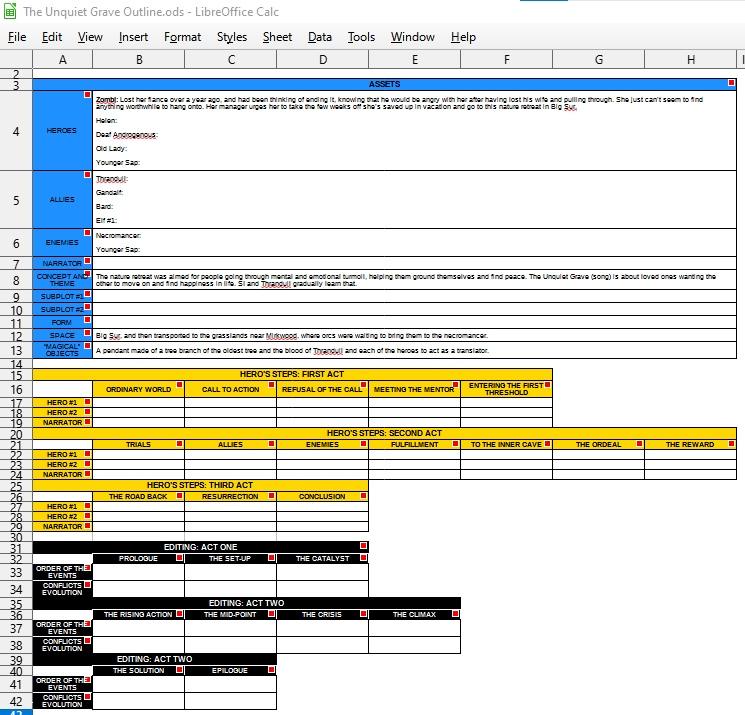
I didn’t use this method for Sequestered Mind, but I did start to use it for another story, called The Unquiet Grave (which is still in the outlining process). In the Assets, you list your heroes, allies, enemies, what sort of narration style, the concept and theme behind the story, a couple of subplots, the setting, and important objects.
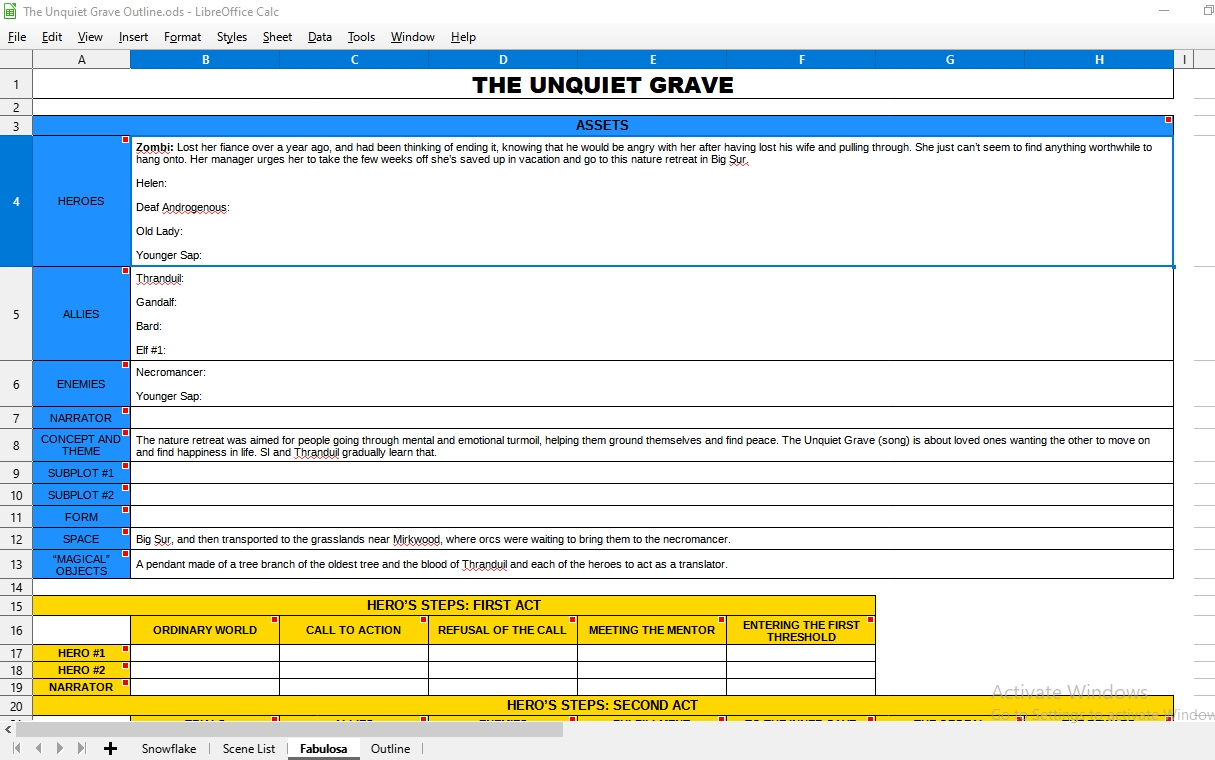
If I had applied this to Sequestered Mind, it would have looked something like this:
| HEROES: | Maggie: the main protagonist, desperate to stay hidden, on the run, and looking for her father.
Storm Hawks: They’re trying to defeat the Cyclonians, but allow Maggie to help them since their paths crossed, and were in line. |
|---|---|
| ALLIES: | Starling: While Starling left the Storm Hawks, she’s still a Sky Knight, and even if Maggie isn’t a friend, she didn’t want her to die.
Oppinsaur: Oppinsaur was Maggie’s father’s best friend, and will be a heartwarming ally and friend to Maggie. |
| ENEMIES: | Cyclonians: They want to destroy Atmos, but Cyclonis also has a personal grudge against Maggie since they were children. |
| NARRATOR: | No identifiable characters are telling the story (third person). |
| CONCEPT AND THEME: | Maggie helps the Storm Hawks to defeat the Cyclonians while looking for Kite, but is really looking for her missing father. Loneliness is a terrible burden to carry. |
| SUBPLOT #2: | Starling’s and Maggie’s relationship. |
| SUBPLOT #3: | Maggie’s relationship with the Storm Hawks. |
| SUBPLOT #4: | Maggie learning the truth about her father and G.O.O.S. |
| FORM: | Third person limited? With some parts showing the villains plotting. I want the voice to at times be overdramatic, like how Stork gets when he rambles on, as if maybe another merb is telling the story. |
| SPACE: | Atmos, a world of mountaintop kingdoms, each guarded by Sky Knights to defend them . . . |
| MAGICAL OBJECTS: | Maggie’s crystal that her father had given her before his disappearance allowed her to change into a human, that she named herself Kite. |
Next, I used another sheet on LibreOffice Calc to write in all of my scene ideas. I generally knew which act the scene would go to, so I placed them under which act. Then, when I thought I came up with enough scenes, I rearranged them in whatever order I chose.
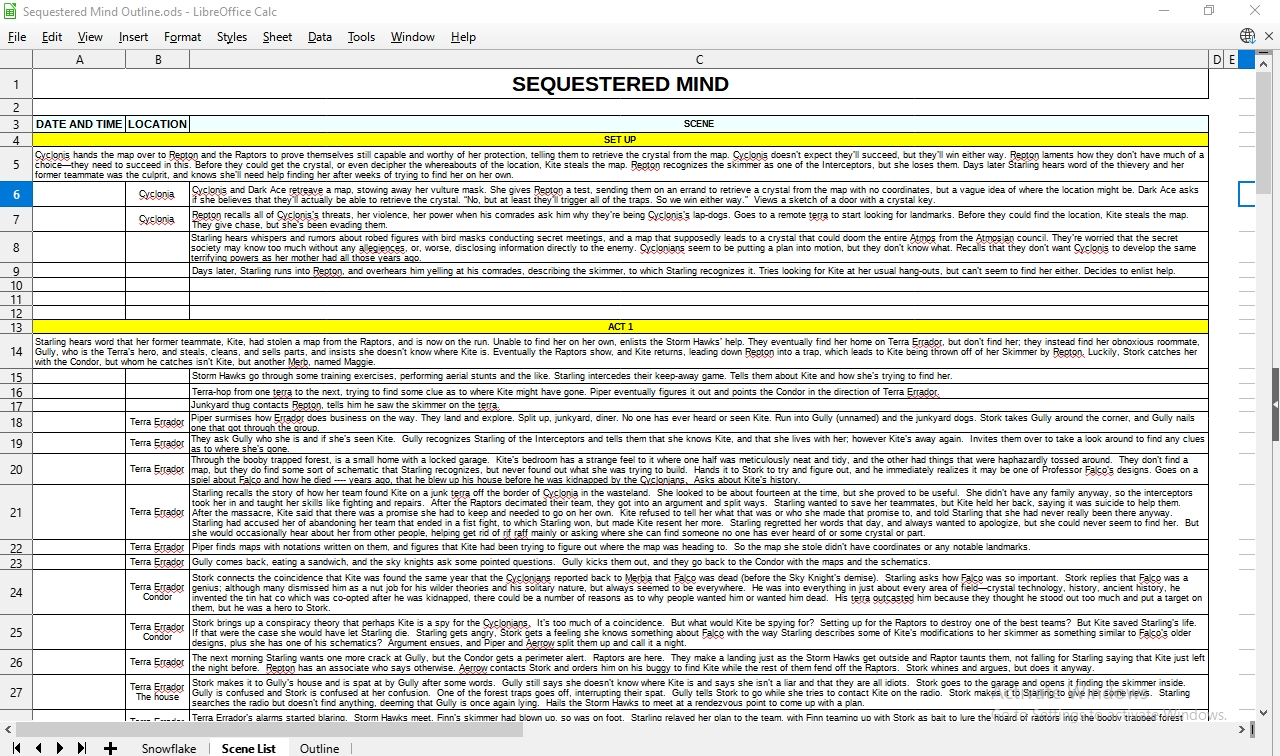
On WaveMaker Cards, I would start off with five cards in the Snowflake tab, each for Setting, Act One, Midpoint, Act Two, and Act Three, and then I would add more scene ideas in whichever stage I knew it would be in. While it’s unfortunate that I can’t freely move the cards around, I can always split the card, and copy and paste what ideas I had in the correct order, and then delete the extra cards.
Finally, I take my scenes from the Snowflake, and copy and paste them under a plot grid. For Sequestered Mind’s case, I had “Stork + Piper” be my main plot because Maggie becoming a Storm Hawk and finding belonging in the team, and with Piper and Stork, was important—more important than even defeating Cyclonis, which was a subplot in the third column, under “Cyclonia”. “Kite + Starling” focused on “finding Kite” and Maggie’s tumultuous relationship with Starling. Would their friendship be fixed, or would it forever be broken? Lastly, we have “Brotherhood + Falco” where “Brotherhood” was a temporary name for the secret society “G.O.O.S.” and this focuses on finding Falco, and then turned into finding whatever clues Falco left behind to stop Cyclonia.
Some scenes fit into more than one plot point, so I merged cells, and whatever cells I couldn’t neatly merge, I filled the cells in purple on LibreOffice Calc. Green cells told me that these scenes are in a different order, vertically.
This plot grid allowed me to see my story in the large scale, allowing me to see where I can insert some foreshadowing, or if there was a large amount of blank space under a certain plot point, it told me I either needed to rethink that plot point or if I needed to come up with more ideas for it. If I knew there was a certain tone I wanted to go for in this scene, or if there was a hidden piece of information I wanted to keep in mind from the reader, I inserted this information in the cell’s comment.

On WaveMaker, once I finished the Snowflake, I would copy and paste each card into a new data card in the Plot Grid tab that functions the same as what I had done in LibreOffice; however, instead of merging cells across multiple columns, I linked the same card under different plot points. These data cards also has a box for the extra, hidden pieces of information I wanted to keep in mind for the scene.
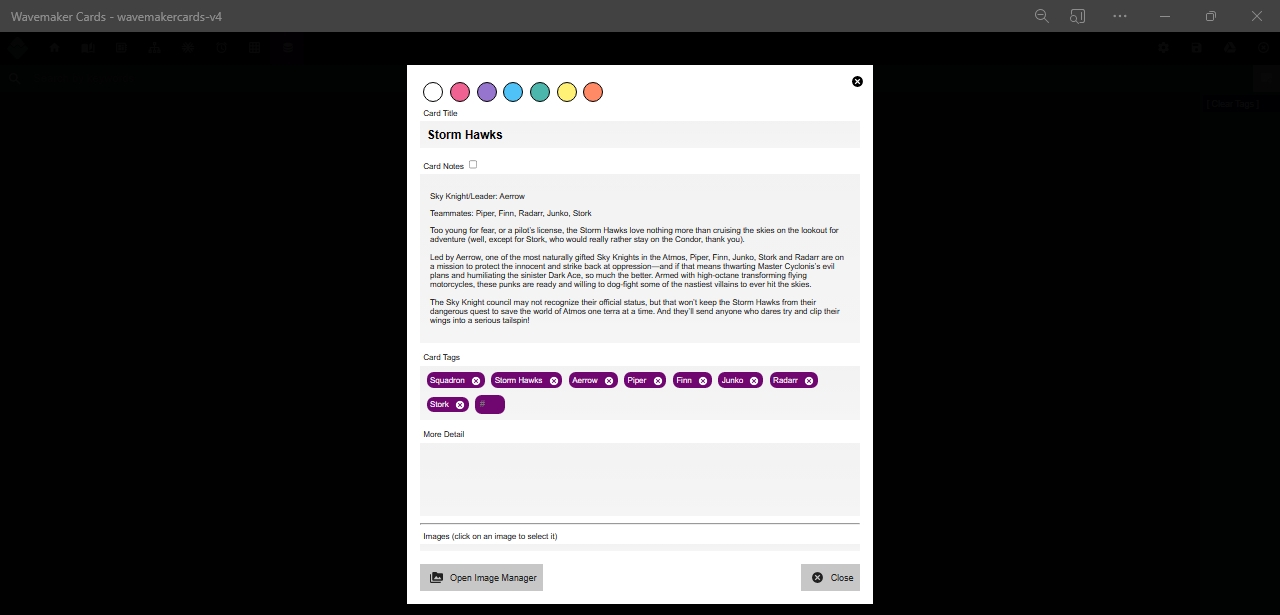
If you notice the numbers in the top of each plot point, those are the number of cards that sit under those plot points, with “Stork + Piper” at 51 cards, “Kite + Starling” at 37 cards, “Cyclonia” at 35 cards, and “Brotherhood + Falco” with 26 cards. Not every plot point will have the same amount of cards or scenes, and that’s OK. It makes sense that the major plot point, the one with the most importance, would have the most cards, even if it isn’t world-saving. Sometimes, plot points end sooner than other plot points, or plot points don’t begin until later in the story, such as what happened with “Brotherhood + Falco”. Sometimes a plot point gets a break, and we come back into it later, such as what happened with “Kite + Starling.”
Variation and which plot points become relevant in which chapter keeps the story interesting.
And don’t think you have to stick with four plot points! You can have as many plot points and columns as you can handle, and you can insert as many rows as you want. In my case, I use the rows as chapters.
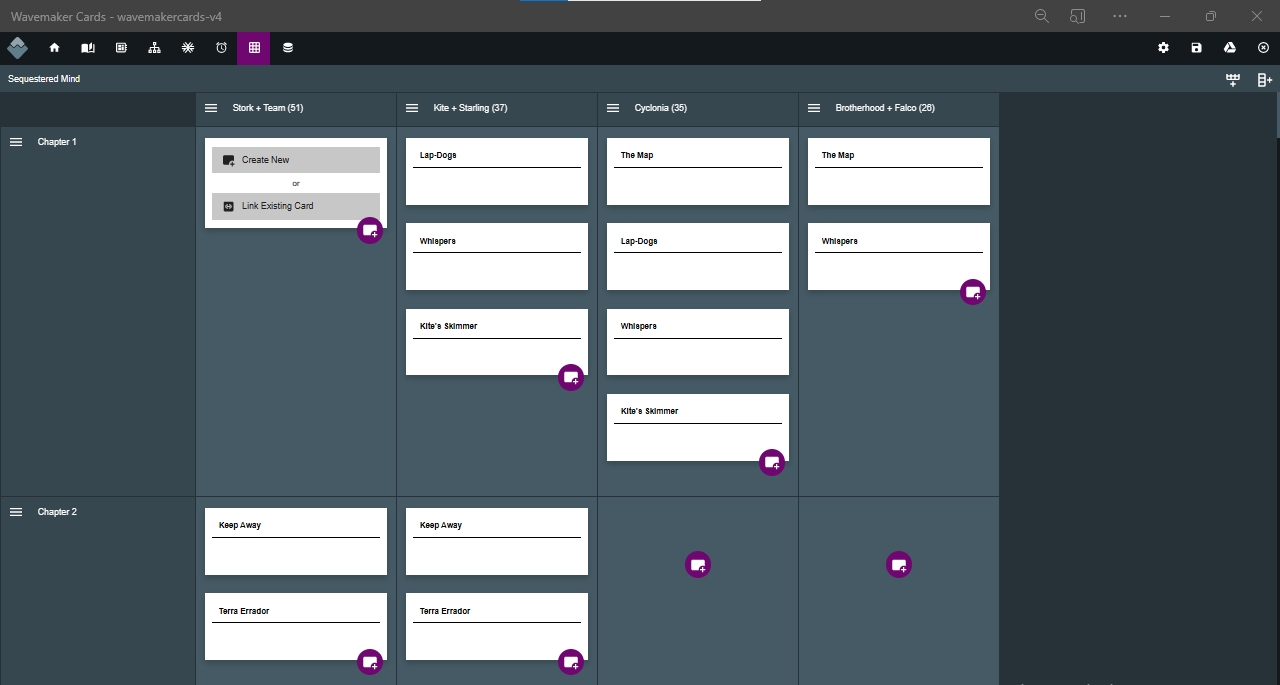
Quickly, I want to show you the Mind Map tab. I don’t tend to use it, but I made one to show you guys as a quick example. And, yes, you can insert images in here as well. I just didn’t have any images.
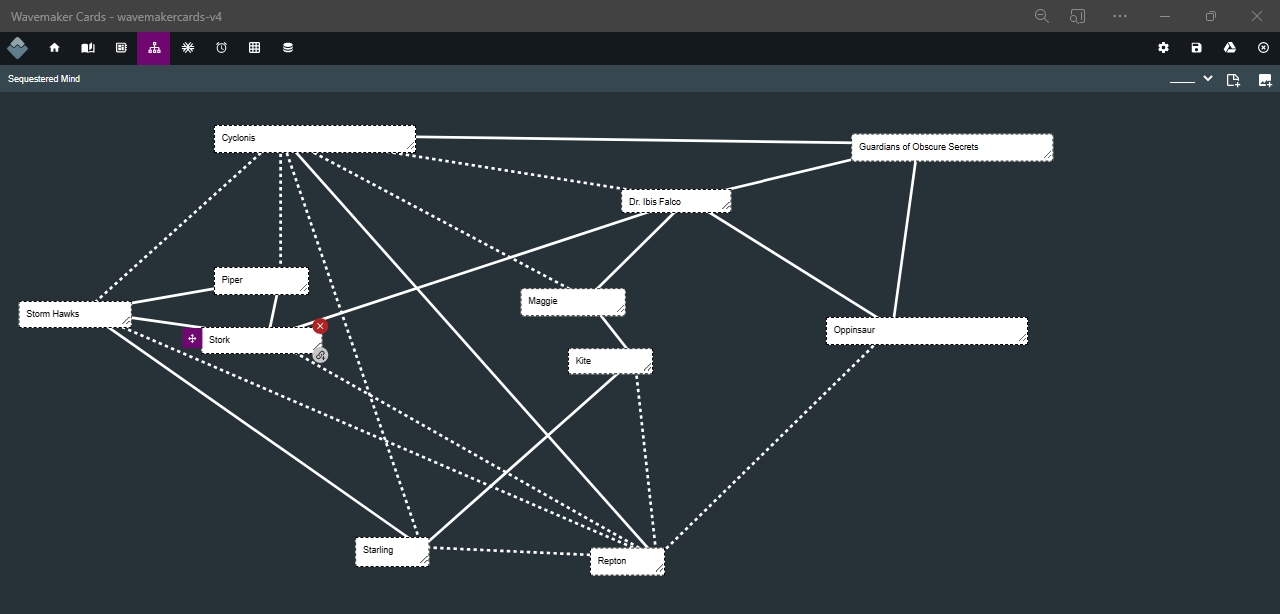
I also don’t tend to use WaveMaker’s Timeline tab, but I used it to copy and paste episode summaries so I had a better idea of when canon events happened in what order. If I ever needed to use a timeline, I could create another one and use it for my story.
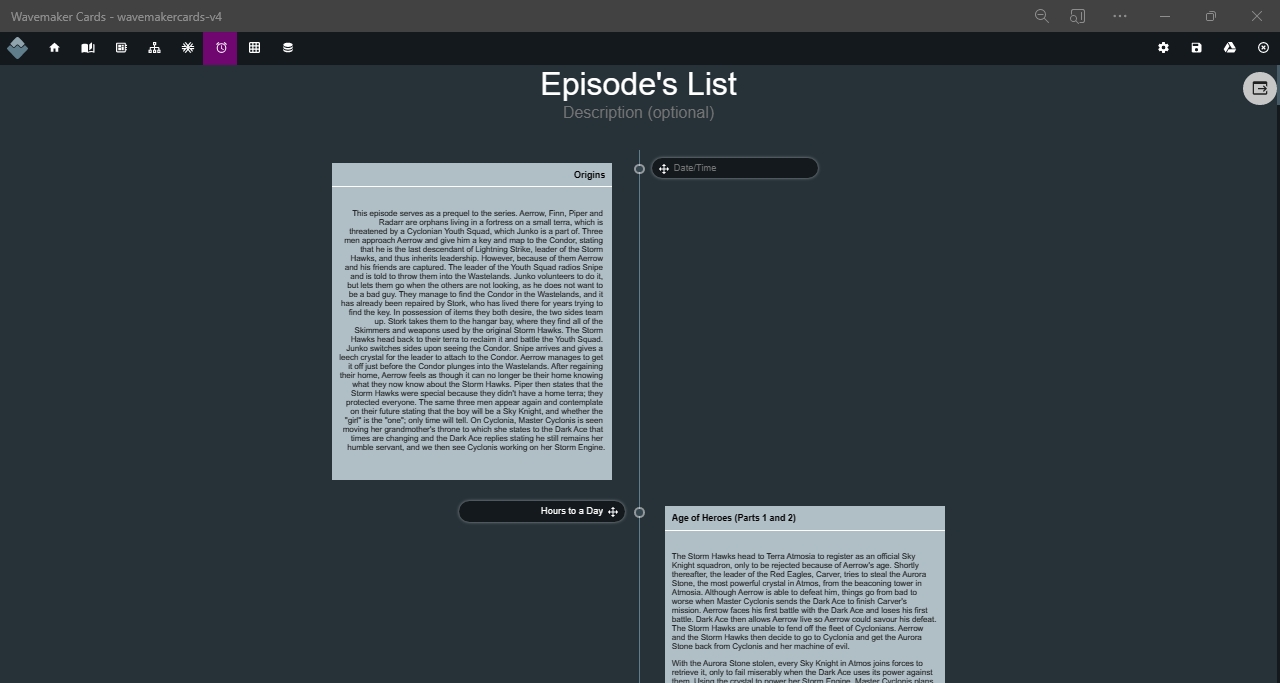
And if you ever wanted to see all of your data cards in full, you can see them in the Data Cards tab. Along with my scene cards for the story, I also used them for research, and for fandom notes. For Sequestered Mind, I had cards about canon characters, crystals, weapons, vehicles, creatures, terras, and all else, along with cloud patterns, weather forecasting, plane parts, and aerial maneuvers. I mainly type them out, but you can insert images into these cards. Another cool thing is that you can insert tags, so if you wanted to filter the list down to only show certain cards, you can click from the list of tags in the right column.
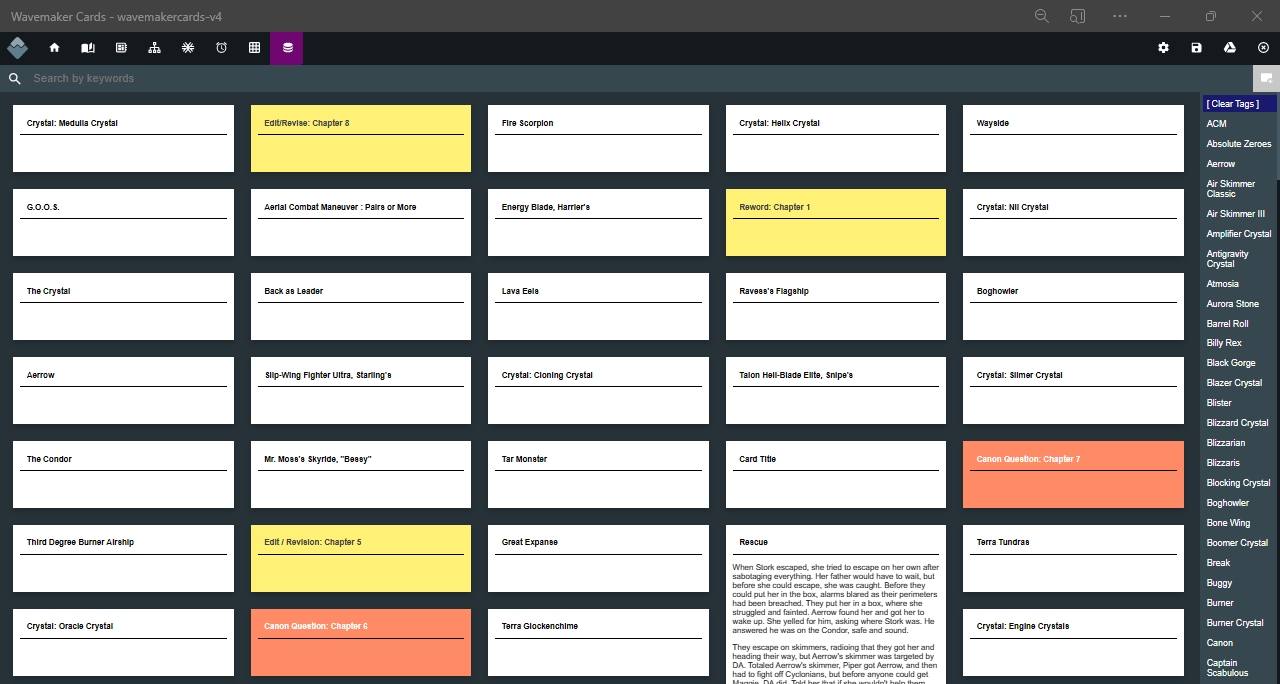
In this example, I wanted to only see cards pertaining to crystals.
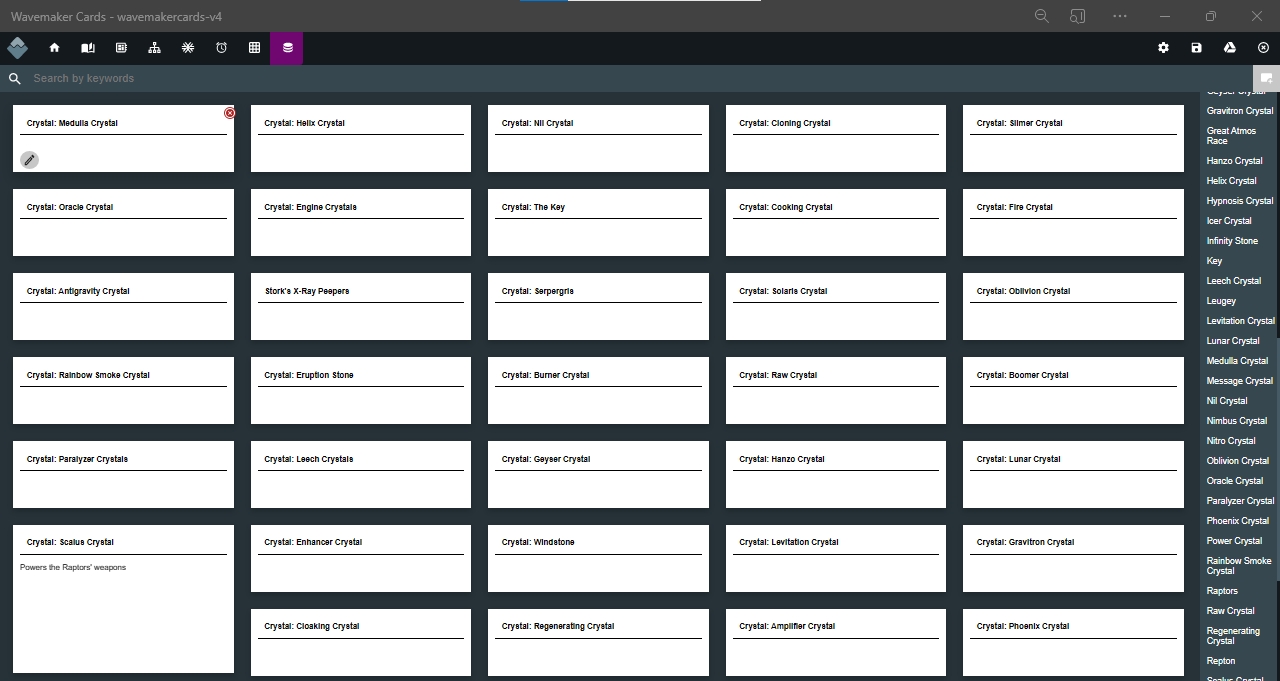
Bonus! You can color code them if you want. I generally keep my cards white unless it’s for editing and revising notes as I write the story.
As a little side-note, all of these cards you see are collapsed, unless it’s for a scene in a story I hadn’t written yet.
Now that we know more about data cards and how they function in WaveMaker, we can get back to outlining. Up next is the Planner. The way I use them is every column contains scenes for a chapter, but I’ve seen people use columns as a single scene broken down further using Dwight Swain’s Large Scale and Small Scale steps. Whichever works best for you, but for me, each column is a chapter, and the data cards that reside in each chapter.

Once I’ve finished inserting and linking all of the data cards under each chapter, all of those data cards are neatly compiled in the Book tab with my list of chapters ready to go.
As you can see, some cards are collapsed and blacked out. This helps me keep track of what I have written and am done with. For the most part, I write from beginning to end, but if I ever had the urge to write a scene early, this would help me see what I had already written.

This is what you first see when clicking on your book (words stats chart).
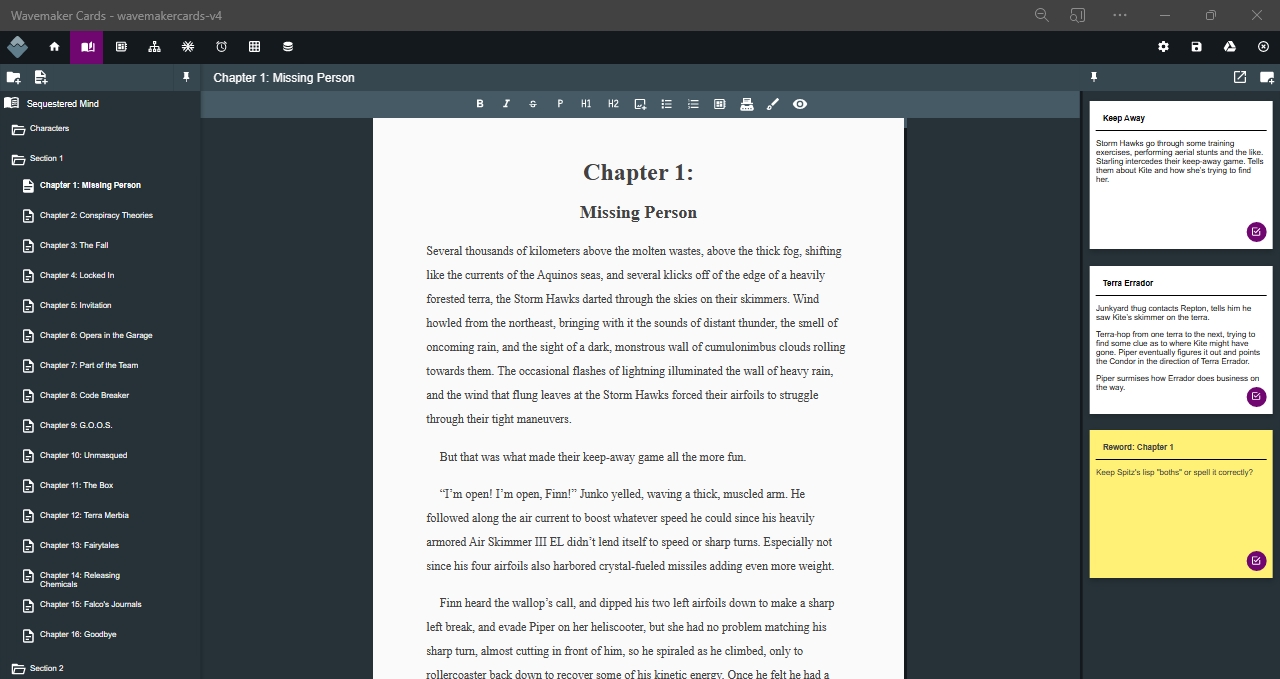
In the Book tab, the left column contains your sections and chapters, the middle is your work document, and the right column contains your data cards for the chapter. The tool bar at the top contains your most basic tools with bold, italics, strike-through, headings and others. There are some keyboard shortcuts, such as if you press the asterisk three times (***) will create a horizontal line, but I don’t know them all. I’m still puzzled as to what the shortcut for the fourth header is. For a distraction-free screen, you can collapse the navigation folder tree, and the data card columns, or you can type on the typewriter, but I need to see my cards for me to write.
By default, you start with a white page with a black font. I usually change it to a dark purple page with a lighter cream font so that I can see it better and it’s less straining on my eyes, but you can change it to whatever color scheme you desire in the settings.
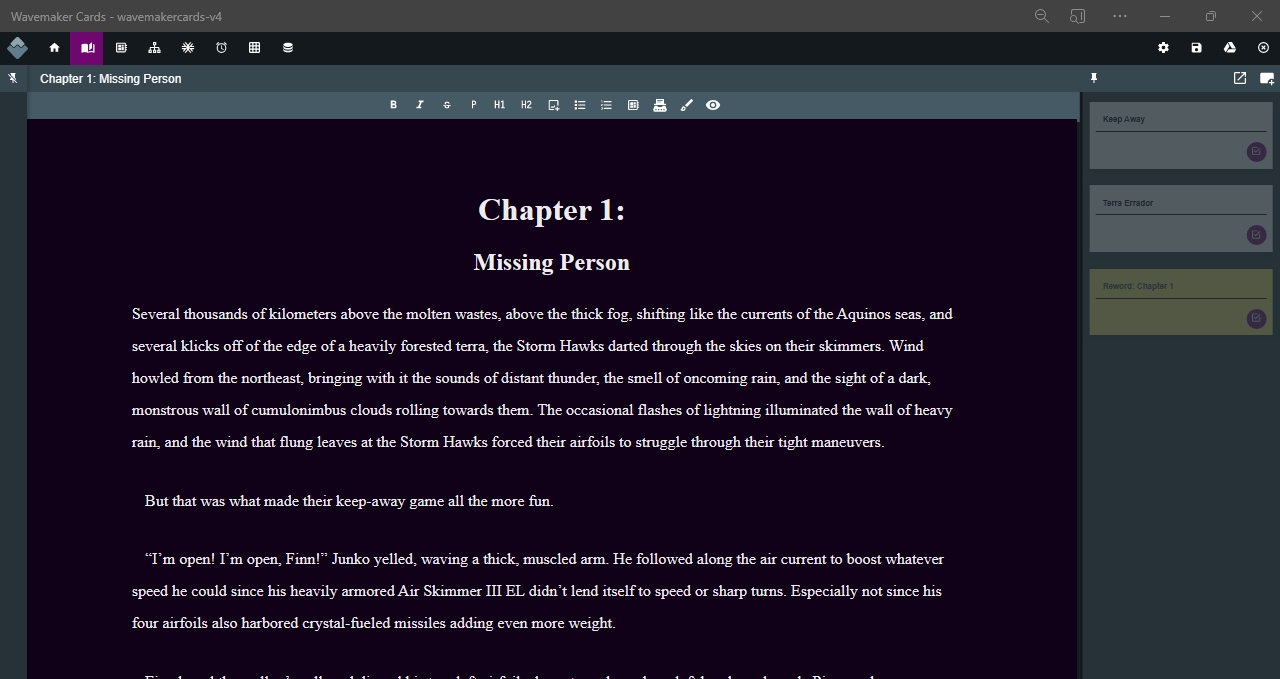
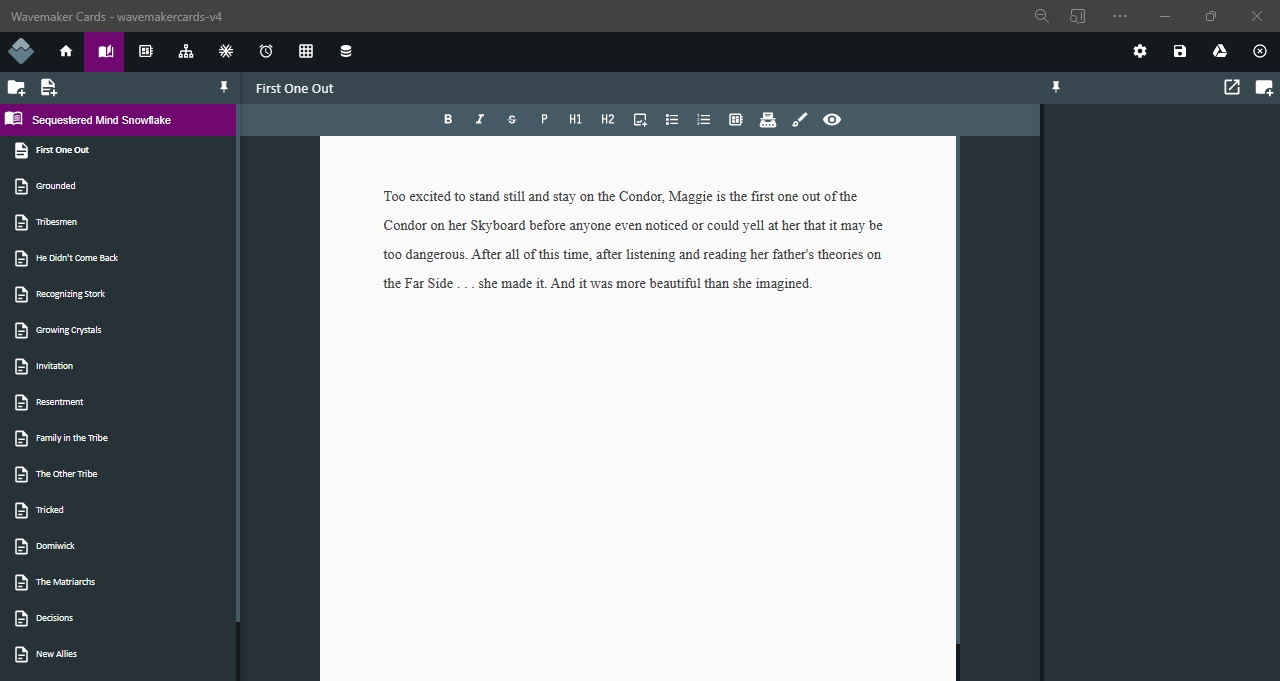
This is what happens when you export your snowflake to a book. Each "card" has its own page.
In the Snowflake tab, you can export it into a book where each card is it’s own page. From there, you can expand the idea, and then create data cards in the right column, which would then create a Story Planner, however, I usually use this just for creating data cards, so there’s less back and forth copying and pasting from the Snowflake tab to the Plot Grid. Once I’m done linking cards to the Plot Grid, I delete this Snowflake book.
I usually keep a series of books together in one WaveMaker Document, which means, I’ll have more than one Snowflake, Plot Grid, Story Planner, and, of course, Books. If you purely navigate using the tabs on top, you’ll just revisit the last document you visited in that tab. To see the menu for that tab, with my multiple documents, I have to go back to the main menu, click on which tab, and then find the document I want to see.
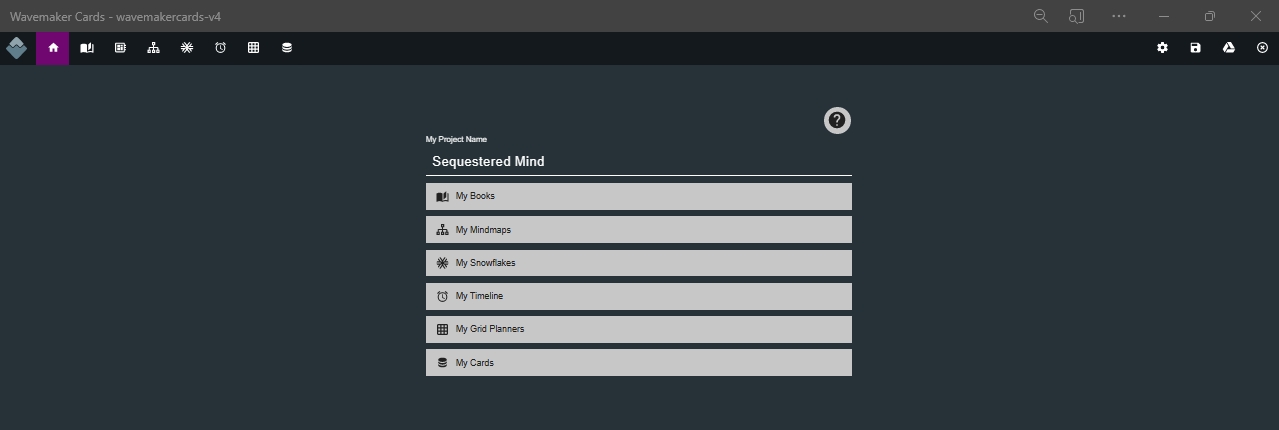
WaveMaker Cards allow you to save right into your Google Docs account, but you can also save a copy to your computer. Every time you save, it’ll create a new file, so you’ll have multiple files of different versions of your document, followed by a date and time you saved it. This is handy in case you accidentally deleted something you didn’t mean to, but you saved it on an earlier document. You’ll find your files under your downloads file.
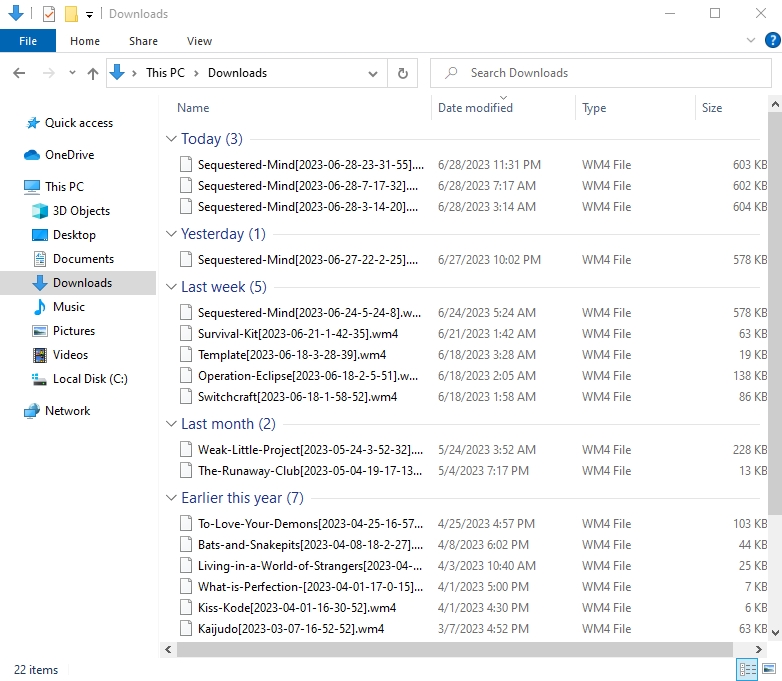
Once my outlining is done, I start writing!
Or you can outline a part of the story, write it, outline some more, write, and on and on until you’re finished with your first draft. This method of outlining is called plantsing, which is a good compromise if you don’t enjoy outlining, but you need more structure than when you try to pants a story.
Do you have any thoughts or questions on what you just read?
Send me an email to let me know!